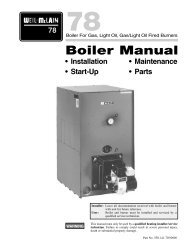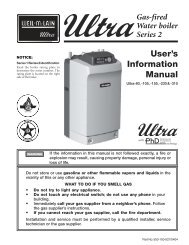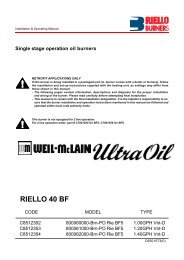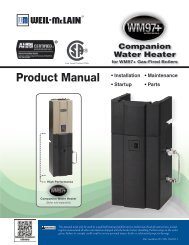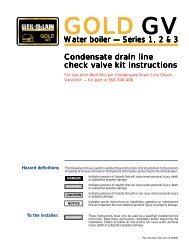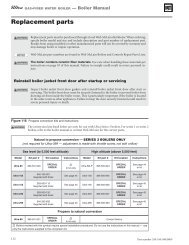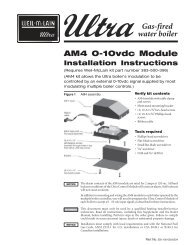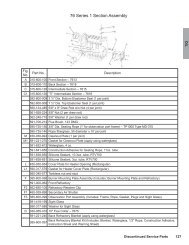Boiler Manual - Weil-McLain
Boiler Manual - Weil-McLain
Boiler Manual - Weil-McLain
Create successful ePaper yourself
Turn your PDF publications into a flip-book with our unique Google optimized e-Paper software.
GV90+ gas-fired water boiler — <strong>Boiler</strong> <strong>Manual</strong>Start-up (continued)Check for gas leaksBefore starting the boiler, and during initial operation,use a leak detector or smell near the floor andaround the boiler for gas odorant or any unusualodor. Remove boiler front door and smell interiorof boiler enclosure. Do not proceed with startupif there is any indication of a gas leak. Repair anyleak at once.DO NOT adjust or attempt to measure gas valveoutlet pressure except where instructed specificallyin this manual. This setting is suitable fornatural gas and propane, requiring no field adjustment.Attempting to alter or measure the gasvalve outlet pressure without following the correctprocedures could result in damage to the valve,causing potential severe personal injury, death orsubstantial property damage.Propane boilers only — Your propane suppliermixes an odorant with the propane to make itspresence detectable. In some instances, the odorantcan fade, and the gas may no longer have anodor. Before startup (and periodically thereafter),have the propane supplier verify the correct odorantlevel in the gas.2. See Replacement parts at the end of this manual for <strong>Weil</strong>-<strong>McLain</strong>part numbers to obtain antifreeze through a <strong>Weil</strong>-<strong>McLain</strong> distributor.Use the correct amount of antifreeze1. Determine the freezing temperature needed (to protect againstlowest likely temperature the system water will encounter).2. Find the antifreeze concentration by volume needed for this temperaturefrom the antifreeze manufacturer’s data on the antifreezecontainer.3. Add up the volume (gallons) of all system piping and components,including the expansion tank and boiler.a. <strong>Boiler</strong> water content is listed in Figure 109, page 101.b. Remember to include expansion tank water content.4. Multiply this volume by the (percent) antifreeze needed to find thenumber of gallons of antifreeze to add.Fill and test water system1. Fill system only after ensuring the water meets the requirementsof this manual.Purge air from water system1. Connect a hose to the purge valve (see purge/drain valves in pipingdiagrams beginning with Figure 17, page 16. Route hose to an areawhere water can drain and be seen.2. Close the boiler or system isolation valve between thepurge valve and fill connection to the system.3. Close zone isolation valves.4. Open quick-fill valve on cold water make-up line.5. Open purge valve.6. One zone at a time, open the isolation valves. Allowwater to run through the zone, pushing out the air. Rununtil no noticeable air flow is present. Close the zoneisolation valves and proceed with the next zone. Followthis procedure until all zones are purged.7. Close the quick-fill water valve and purge valve andremove the hose. Open all isolation valves. Watch thatsystem pressure rises to correct cold-fill pressure.8. After the system has operated for a while, eliminateany residual air by using the manual air vents locatedthroughout the system.9. If purge valves are not installed in system, open manualair vents in system one at a time, beginning with lowestfloor. Close vent when water squirts out. Repeat withremaining vents.10. Open automatic air vent (diaphragm-type or bladdertypeexpansion tank systems only) one turn.11. Starting on the lowest floor, open air vents one at a timeuntil water squirts out.12. Repeat with remaining vents.Pressurize system1. Close manual and automatic air vents and boiler drainvalve.2. Fill system to correct system pressure. Correct pressurewill vary with each application.a. Typical cold water fill pressure for a residentialsystem is 12 psi (when using a 30 PSIG boiler reliefvalve).b. Pressure will rise when boiler is turned on and systemwater temperature increases. Operating pressuremust never exceed 5 PSIG less than the boiler reliefvalve setting.3. At initial fill and during boiler startup and testing, checksystem thoroughly for any leaks. Repair all leaks beforeproceeding further.Eliminate all system leaks. Continual freshmake-up water will reduce boiler life. Mineralscan build up in sections, reducing heat transfer,overheating heat exchanger, and causingheat exchanger failure.Use inhibitor supplied with boiler1. The GV90+ boiler is shipped with Sentinel X100 inhibitorand Sentinel inhibitor test kit. See Replacement partsat the end of this manual for re-ordering information.2. After filling the system as directed in these instructions,use a caulking gun to inject the X100 inhibitor into thesystem, following the instructions on the tube.60Part number 550-142-054/1211




